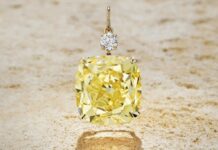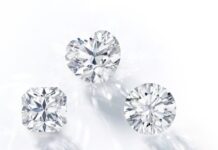
Lab diamonds have emerged as a favored choice for engagement rings, appealing to modern preferences for sustainability and affordability. These diamonds, grown in controlled lab environments, match their mined counterparts in beauty and durability. They offer a unique blend of technology and tradition, capturing the essence of what many couples seek today—a symbol of their love that’s both ethical and exquisite.
The evaluation of diamond quality, whether lab-grown or mined, is based on the globally accepted standard known as the 4Cs: Cut, Color, Clarity, and Carat. This standard provides a comprehensive method to assess the worth and beauty of diamonds.
The Cut of a diamond influences its brilliance and sparkle, a key aspect of any engagement ring. The Color grade helps in determining the hue and tone, which can range from colorless to light yellow. Clarity refers to the purity of the diamond, assessing any internal inclusions or external blemishes. Lastly, Carat measures the weight, directly impacting the size of the diamond.
Understanding these 4Cs is crucial for anyone considering a lab diamond engagement ring. This knowledge not only aids in making an informed choice but also ensures the selection of a ring that truly resonates with personal preferences and values.
- Cut: The Art And Science Behind Sparkle
The cut of a diamond is a critical factor that determines its overall brilliance and fire, especially in lab diamond engagement rings. This aspect of a diamond’s quality is not just about its shape but involves the precision of its facets and their alignment. The way a diamond is cut influences how light travels within it, affecting its ability to sparkle and catch the eye. A well-cut diamond reflects light beautifully, showcasing its best qualities.
In the realm of lab diamond engagement rings, the array of cut styles and shapes is vast and varied. Each cut, whether it’s the timeless elegance of the round brilliant or the contemporary charm of the princess cut, brings out different aspects of the diamond’s beauty. The choice of cut is more than an aesthetic preference; it’s a reflection of how light interacts with the diamond. This interaction plays a significant role in determining the stone’s overall allure and brilliance.
Precision cutting is paramount in lab diamonds, particularly when considering alternatives to mined diamonds. This meticulous process is focused on maximizing the diamond’s ability to reflect and refract light. The precision of each cut enhances the stone’s natural beauty, ensuring that the diamond sparkles with maximum intensity.
- Color: Grading The Hue Of Lab Diamonds
Color grading in diamonds, an integral part of the 4Cs, plays a pivotal role in evaluating both lab-grown and mined diamonds. This grading follows a standardized scale from D, representing colorless, to Z, indicating a light yellow or brown hue. In lab diamond engagement rings, the color grade directly impacts the gemstone’s aesthetic and value. The pursuit of higher grades, especially those closer to D, signifies a quest for diamonds with minimal color, reflecting purity and rarity.
The science behind achieving specific color grades in lab diamonds is a fascinating blend of technology and expertise. In the lab, conditions are meticulously controlled to replicate the natural formation of diamonds, which influences their color. Factors like pressure, temperature, and the presence of certain elements can alter the hue of the diamond, necessitating precision in the creation process.
Comparing the color variations between lab and mined diamonds reveals interesting insights. While both types can span the entire color scale, the controlled environment of lab growth allows for more consistent outcomes. This consistency is a testament to the advancements in technology and skill that go into crafting lab-grown diamonds. It highlights the ability to produce high-quality diamonds with desired color characteristics, a factor of immense importance in the world of fine jewelry.
- Clarity: Evaluating The Purity Of Lab Diamonds
Clarity in diamonds is a vital aspect in determining their value and appeal. It refers to the absence or presence of inclusions and blemishes within or on the surface of the diamond. Clarity is a measure of the purity and perfection of a diamond, with higher clarity grades indicating fewer imperfections. In the context of lab diamonds, clarity not only influences their market value but also reflects the sophistication of the technology used in their creation.
Lab-grown diamonds can exhibit a range of inclusions and blemishes. These may include internal characteristics like pinpoints, clouds, and feathers, and external features like scratches or pits. The types and extents of these imperfections vary, making each diamond unique. While some believe that imperfections diminish a diamond’s value, others view them as signatures of identity, adding a distinct character to each stone.
In the lab, advanced techniques are employed to enhance or maintain the clarity of diamonds. These methods include careful control of the growth environment to minimize the formation of inclusions. Scientists and technicians strive to replicate the natural diamond formation process while reducing flaws. The pursuit of perfection in lab diamonds goes beyond achieving high clarity grades. It involves crafting gems that embody natural beauty and artistry.
- Carat: Measuring The Weight And Size Of Lab Diamonds
Carat weight is a fundamental measure in the world of diamonds, directly influencing the size and, consequently, the visual impact of these precious stones. A carat, equivalent to 0.20 grams, is the unit used to express the weight of diamonds, including those grown in labs. The larger the carat weight, the bigger the diamond appears. This aspect is crucial in choosing lab diamond engagement rings, as the size of the diamond often symbolizes the magnitude of the sentiment it represents.
In the realm of lab-grown diamonds, technological advancements have a significant impact on the achievable carat size. The controlled conditions of labs allow for the growth of larger diamonds than might be typically found in nature. This ability to influence the size of the diamond through lab methods presents an advantage, offering flexibility in catering to diverse preferences and budgets.
When comparing the carat sizes of lab diamonds with mined diamonds, it’s noteworthy that lab-grown diamonds often provide larger sizes at comparable price points. This difference is due to the efficiency and scalability of lab processes. The intrinsic value and sentiment behind both types of diamonds are high. However, lab-grown diamonds provide an alternative that better aligns with individual desires and values.
Conclusion
Understanding the 4Cs of lab diamond engagement rings reveals the meticulous science behind their creation. This knowledge is vital for those looking to make an informed choice.
Lab diamonds, shaped by both technology and nature’s principles, provide a sustainable and ethical option in the world of fine jewelry. Recognizing the art and science in these gems allows for a deeper appreciation of their value and significance.
As the world of diamonds evolves, lab-grown options stand out as a thoughtful and contemporary choice, reflecting both personal taste and a commitment to responsible choices.
Disclaimer: This information has been collected through secondary research and TJM Media Pvt Ltd. is not responsible for any errors in the same.

























